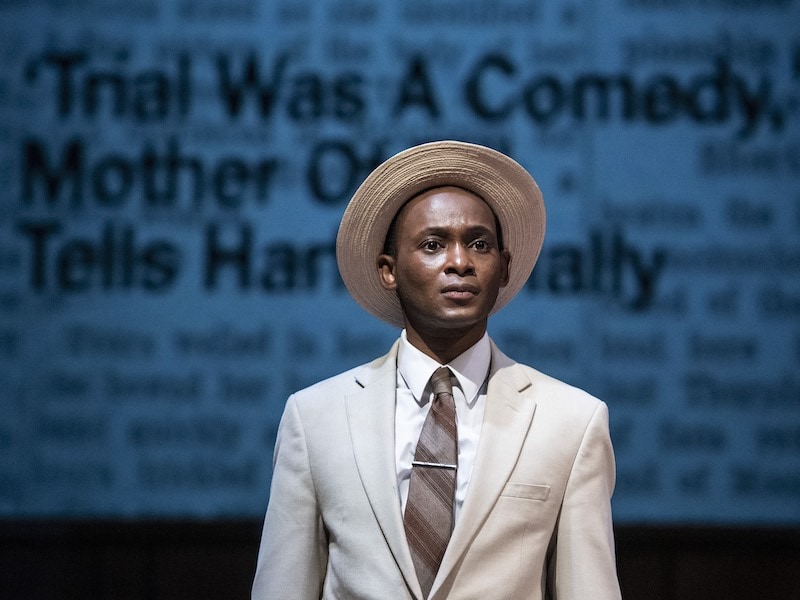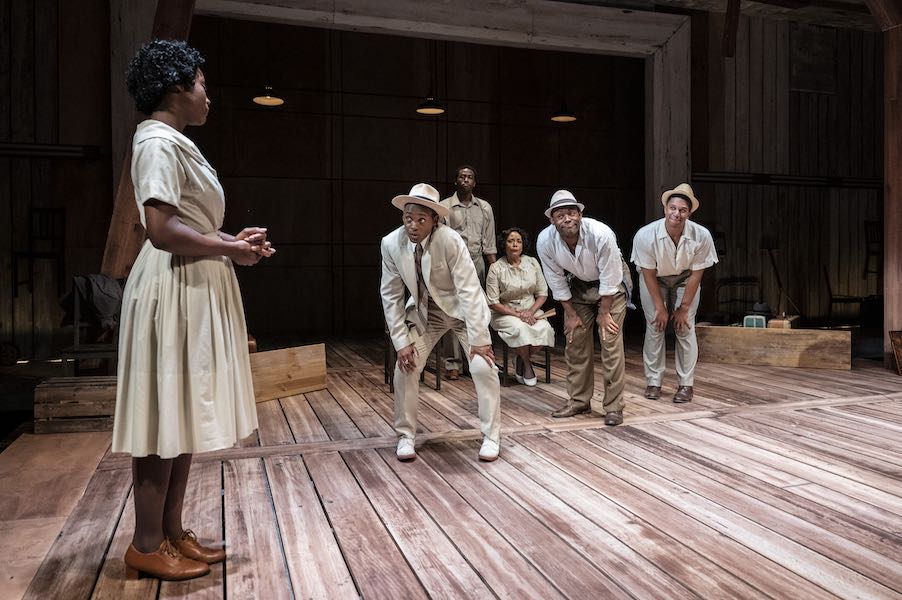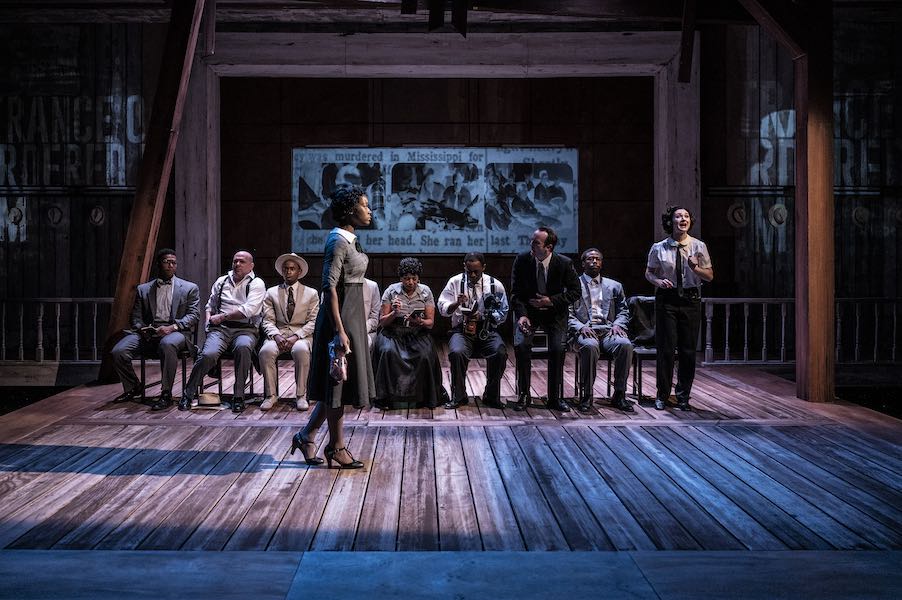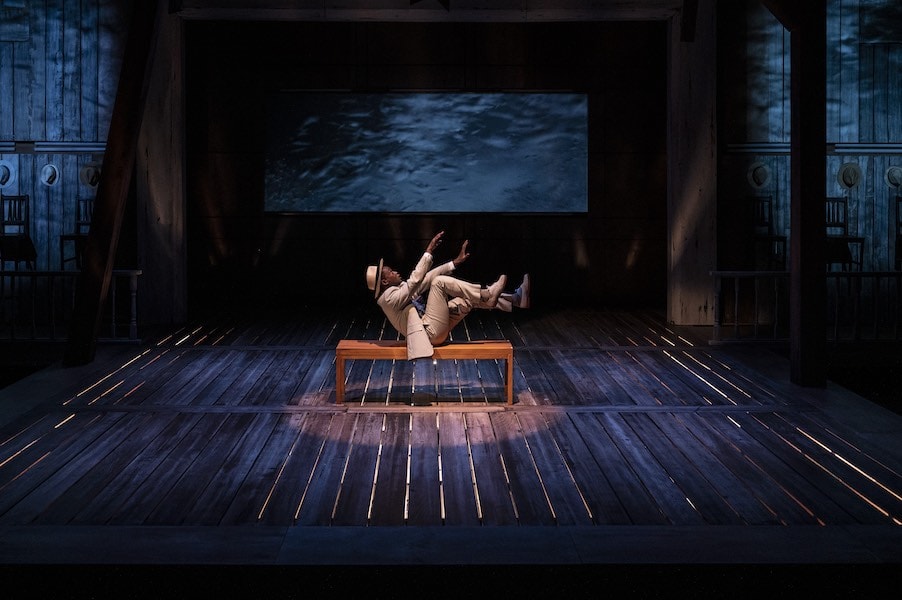“How will we share the future if we cannot be instructed by grief.”
—Essex Hemphill, Black gay poet
“Everybody knows about Mississippi, Goddam!” —song by Nina Simone
“Our house is a very, very, very fine house.” —song by Graham Nash
The Till Trilogy by Ifa Bayeza is three plays in repertory that tell the story of the final, fatal summer in the life of a Black boy named Emmett Till.
You can see them in any order, and you can see as many or as few of them as you like. But seen all together they make for an undeniably powerful event. The play cycle now at Mosaic Theater is such an ambitious and panoramic emotional roller coaster and visual spectacle that it could as well have been called
The Passion of Emmett Till
or
The Persecution and Assassination of Emmett Till by the Poor White Trash Roy Bryant under the Instigation of His Wife, A Former Southern Beauty Queen, with the Implicit Support of the White Citizens and Descendants of the Defeated Confederacy of These United States.

The Till Trilogy does many things. It entertains and stimulates with its set and sound design and its evocative projections. It grabs us with its performances, especially the startling performance of Antonio Michael Woodard, who portrays the boy Emmett Till without stinting on the ways an energetic adolescent can be irritating. Woodard is not the only performer to hold our attention. All of the actors (Scott Ward Abernethy, Jasen Bowen, Anna DiGiovanni, Christopher Genebach, Drew Kopas, Billie Krishawn, Vaughn Ryan Midder, Rolonda Watts, Jaysen Wright) play multiple parts and serve as fit containers for the lives of people who actually existed and who, for some of us, occupy a deeply remembered but rarely explored area of our memories.
And by visiting this rarely explored area of our memories, there is something else that The Till Trilogy accomplishes. It gives us a way — a “safe” space — to look at an especially salient moment in our country’s history of white supremacist–propelled terrorism directed toward Black people. It attempts to give us an Archimedean point of leverage from which to reevaluate that trauma. The plays that comprise The Till Trilogy are beautiful, haunting, and horrifying to watch.
In August 1955, 14-year-old Emmett Till left Chicago to visit relatives in Sumner, Mississippi. While there, one day, with his cousins, he went into a country store in Money, Mississippi, and bought some candy. He may have whistled at Carolyn Bryant, a white woman, who was operating the store at the time. Upon learning of this, Roy Bryant, Carolyn Bryant’s husband, and J. W. Milam, her brother-in-law, armed themselves and went in search of the boy. They entered the home of Emmett’s uncle, Moses Wright, and kidnapped and brutally murdered the boy, gouging out one eye, beating him until his face was unrecognizable, shooting him in the head above his right ear. They weighted his body with an industrial fan blade, fastened around his neck with barbed wire. Then they threw him into the river. His mother, Mamie Till-Mobley, worked to halt an immediate burial and called several local and state authorities in Illinois and Mississippi to make sure that her son’s body was brought back to their home in Chicago. She held a funeral with an open casket to make sure the brutality perpetrated on her son was displayed to the public. She traveled to Mississippi and testified at the trial. After an hour of deliberation, the all-white jury found Milam and Bryant not guilty. After the trial in an interview in Look magazine, the two men confessed to the killing.
I saw the plays in this order: Benevolence, The Ballad of Emmett Till, That Summer in Sumner. Seeing Benevolence first prepared me to pay attention to subtle expressions of trauma as they arose in characters throughout the plays. It also made clear that there is more to this story than what is shown in linear presentation of the events.
Benevolence explores how the toll of ruthlessly maintaining white supremacy as an economic and caste system affects our most intimate relationships: those of families and lovers. Each act of this two-act play focuses on a separate family: one white and one Black. The first act, which could easily have been called The Private Lives of the Master Race, imagines the lives of Carolyn and Roy Bryant, the perpetrators of the Emmett Till murder. At the end of this first act, I wondered, “How can benevolence come from this?”

The second act imagines the lives of a Black couple, Beulah and Clinton Melton, who were neighbors of Emmett Till’s cousins. Mixed in with their morning coffee and eggs, the repair of automobiles, and their courting, sparking, and marriage tiffs, they endure their own parallel, less publicized tragedy as part of the everyday terrorism inflicted on Black folks in the South. It is in this play’s final scene that one of their grownup (62-year-old) children articulates what she sees as the possibilities of benevolence.
The Ballad of Emmet Till is an account of the last two weeks of Emmett Till’s life. Whereas the other two plays focus on the world around Emmett, Ballad is Emmett’s story. In it, our attention is focused on the fact that Emmett Till was 14 years old. The playwright gives us a portrait of what life is like for this stuttering adolescent, who is in the process of discovering who he is, what the world is, and what he can be in it. We see him learning to drive, his enthusiasm for life, his excitement about visiting his cousins down south. We see his awkwardness as a city boy in the country, working in the fields and killing and plucking the feathers of a chicken for the family’s dinner. In addition to his cuteness, I also get a sense that in today’s hyper-medicalized world he might be diagnosed with ADHD. And I wonder whether I would have been able to put up with this kid 24 hours a day.

Then we see his abduction, his torture, and his killing.
Suffused with music, this play is literally a ballad in the tradition of The Ballad of John Henry and Ballad of Henry T. Moore: songs that tell of a hero’s journey in which the hero endures trials, and experiences transfiguration (at least in the hearts and minds of those who live on and hold them in high esteem). At the beginning, the Ensemble sings:
Come on let me tell you bout,
Bout Emmett Till/ Come on, let me
Tell you bout, bout Emmett Till/
They tried to break his body,
But could not break his will
thus foreshadowing and envisioning his apotheosis in the pantheon of African American saints. And finally, we hear Emmett’s last words in this ballad (echoing the last words of the crucified Christ): “It is done?”
That Summer in Sumner is set during the trial of Roy Bryant and J. W. Milam. It highlights the machinations of the courtroom, focusing on what Emmett’s family members and the Black press had to endure in pursuit of the truth and justice in a system that had no intention of delivering either. I have never thought about the photographer who took the picture of the body of Emmett Till that so shocked the world. And the fact is that he was not the only Black journalist on the scene. This play illustrates what laws of equality meant on the ground, in a society determined to be exclusively white supremacist, as opposed to what was said on paper.

I found the way that lines from one play are repeated in another play to be seductive. These recurring lines functioned for me like ghostly presences. Emmett’s whistling (with its echo in train whistles throughout the bayou) also reverberates throughout the three plays. These ghostly presences also suggest the way this story echoes in the consciousness of many Black Americans today. It’s like a representation of trauma as a kind of haunting.
The image of the edifice that is the United States of America being a house that is haunted by its history is also effectively embodied in the production’s set (Andrew Cohen), lights (Alberto Segarra), and projections (Mona Kasra). The stage on which all three plays are performed evokes an old house with a wooden floor, which you can see light seep through in the spaces between floorboards. These floors squeak or rumble unexpectedly with every movement someone makes (or maybe it’s just a settling of the house). They disturb your peace, suggesting a presence where none is, announcing a presence that is unknown and possibly uninvited.
The projections were useful. There were motion picture images of Black children and infants in the 1950s that were not caricatures. I had not seen any of these images before and I had no idea that they existed. They were a pleasant discovery. There were also images of water dripping into the swampy bayou that surrounded the homes of the residents of the Mississippi Delta — swamps the depths of which were dark and unfathomable and into which one knew the bodies of many an Emmett Till might have been tossed.

The Till Trilogy is a large endeavor to pull together. Director Talvin Wilks guides this production with passion, vision, and humility. Every actor seemed freed rather than confined by the direction.
In The Till Trilogy, playwright Ifa Bayeza and director Talvin Wilks have given us a jewel of a production. I am grateful that it exists.
Running Times:
The Ballad of Emmett Till – 90 minutes no intermission
That Summer in Sumner – 105 minutes, 15-minute intermission
Benevolence – 120 minutes, 15-minute intermission
The Till Trilogy plays in repertory through November 22, 2022 — on Wednesdays at 8 PM, Thursdays at 11 AM and 8 PM, Fridays at 8 PM, Saturdays at 3 PM and 8 PM, and Sundays at 3 PM — presented by Mosaic Theater Company performing in the Sprenger Theatre at Atlas Performing Arts Center, 1333 H Street NE, Washington, DC. For the schedule and to purchase tickets ($29–$64), go online or contact the Box Office at (202) 399-7993 or [email protected] from 11 AM – 5 PM Monday through Friday, or two hours prior to a performance.
The program for The Till Trilogy is online here.
COVID Safety: All patrons are required to be masked while inside performance spaces. The use of N95 masks is encouraged. Masks may be optional in other areas of the building, including lobbies. The complete Atlas Performing Arts Center COVID policy is here.
The Till Trilogy
Written by Ifa Bayeza
Directed by Talvin Wilks
Cast
Antonio Michael Woodard (Emmett Till), Scott Ward Abernethy (Ensemble), Jasen Bowen (Ensemble), Anna DiGiovanni (Ensemble), Christopher Genebach (Ensemble), Drew Kopas (Ensemble), Billie Krishawn (Ensemble), Vaughn Ryan Midder (Ensemble), Rolonda Watts (Ensemble), Jaysen Wright (Ensemble)
Creative and Production
Scenic Designer: Andrew Cohen
Lighting Designer: Alberto Segarra
Projection Designer: Mona Kasra
Costume Designer: Danielle Preston
Sound Designer and Composer: Kwamina “Binnie” Biney
Associate Sound Designer: Dominique Perera
Vocal Arranger: Paige Rammelkamp
Additional Arrangements and Music Direction: Rickey Payton, Sr.
Properties Designer: Deb Thomas
Fight and Intimacy Director: Sierra Young
Dramaturg: Faedra Chatard Carpenter
Dialect Coach: Jen Rabbit Ring
Assistant Director and Choreographer: Sandra L. Holloway
Stage Manager: Shayna O’Neill




